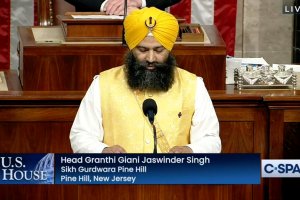The United States Army this week authorized religiously mandated beards and turbans for active-duty military personnel, ending discrimination against Sikhs and others.

Secretary of the Army Eric K. Fanning announced in a January 3 memo that “based on the successful example of soldiers currently serving with these accommodations, I have determined that brigade-level commanders may approve requests for these accommodations.”
Authorization for Sikh soldiers to wear beards and turbans, and hijabs for Muslim women, must be granted across all duty positions and denied only in the case of a “concrete hazard” that cannot be avoided by reasonable measures.
The decision emerged from two lawsuits filed against the Department of Defense in February 2016 by the Sikh Coalition, religious freedom organization Becket Law, and law firm McDermott Will & Emery, on behalf of four Sikh American soldiers.
Sikhs have served in the U.S. Army since World War I
Capt. Simratpal Singh, a West Point graduate and Bronze Star recipient, dismissed his case in July 2016 after being granted permanent permission to wear a turban and beard on active duty. The cases of three other Sikh soldiers were dismissed this week, concurrent with the announcement of the Army’s new policy and assurance of accommodation.
The Army regulation of permitting beards for medical reasons, such as skin conditions, but not for religious reasons—cutting hair and beards is barred by the Sikh religion—had long been viewed as discrimination against Sikhs, both those on active duty and those seeking to enter the military. The Sikh Coalition argued that the prohibition on Sikh soldiers wearing the turban and beard violated the Religious Freedom Restoration Act of 1993 and severely limited Sikhs entering the military.
Sikhs have served in the U.S. Army since World War I—138,000 fought with the Americans and other Allied forces. A large number of Sikhs also fought under Allied command in World War II, earning a reputation for valor.
For decades, all branches of the U.S. Armed Forces allowed beards. New regulations in the 1980s permitted only those who started their military service prior to 1986 to retain beards, effectively barring observant Sikh men from serving in the U.S. military without compromising their religious practice. Those who did serve either shaved their beards and wore no turban or they requested accommodation which was granted, or not, on a case-by-case basis.
The new accommodations include specific directives on the length of beards, and turbans must match the uniform. And until protective masks for use in hazardous environments are developed for bearded soldiers, they will not be eligible for certain training involving toxic chemicals.
Hijabs for Muslim females are also permitted, as long as they are subdued colors or a camouflage pattern that closely matches the uniform.
“We are pleased with the progress that this new policy represents for religious tolerance and diversity by our nation’s largest employer.”
“The Sikh articles of faith have always been consistent with the best of American values so we’re pleased that the burden no longer rests with Sikh soldiers to prove this through a lengthy administrative process,” said Amandeep Sidhu, partner at McDermott Will & Emery and a member of the pro bono team litigating the suits against the Defense Department.
“While we still seek a permanent policy change that enables all religious minorities to freely serve without exception,” said Sikh Coalition Legal Director Harsimran Kaur, “we are pleased with the progress that this new policy represents for religious tolerance and diversity by our nation’s largest employer.”
For the full text of the Secretary of the Army memorandum, see https://www.sikhcoalition.org/wp-content/uploads/2017/01/01-04-2017-Army-Directive-Religious-Accommodation.pdf.


